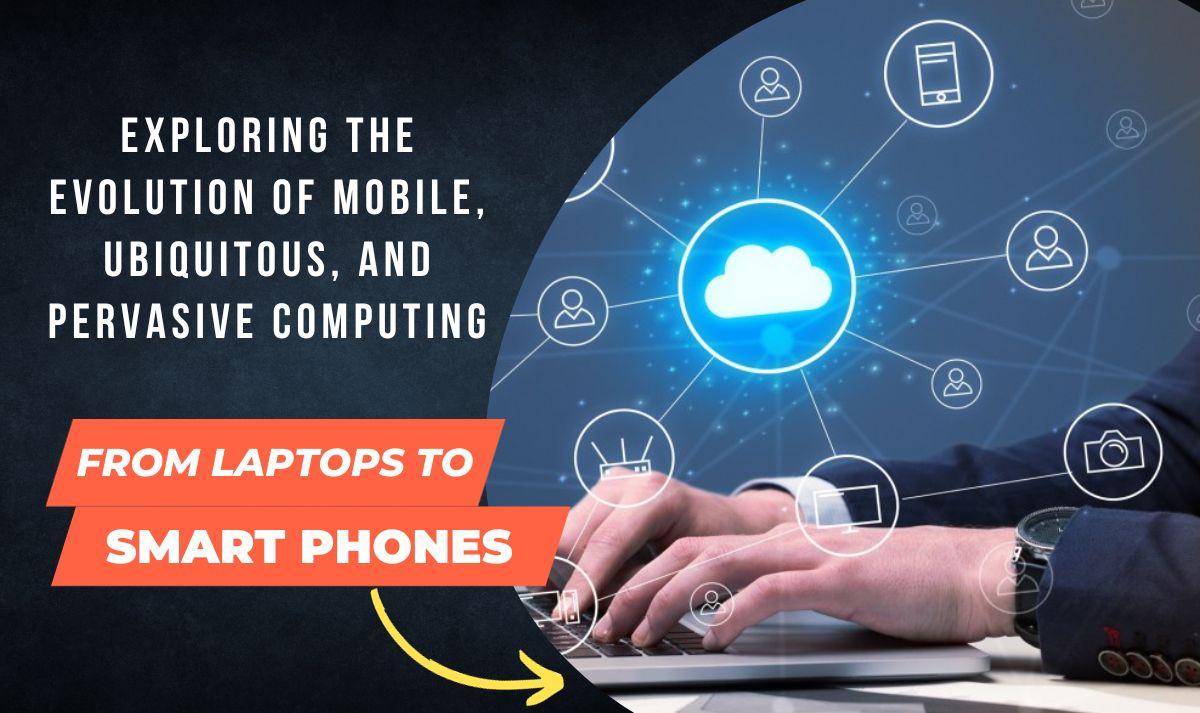
The evolution of computing has been marked by a transformative journey from stationary desktops to the portable and interconnected world of laptops and smartphones. In this exploration, we delve into the history, characteristics, and implications of mobile computing, ubiquitous computing, and pervasive computing. From the advent of laptops to the rise of smartphones, these paradigms have not only changed the way we interact with technology but have also become integral to our daily lives.
The Rise of Laptops: Portability Redefined
Early Days of Portable Computing
The concept of portable computing can be traced back to the early days of laptops, which emerged as a solution to the limitations of desktop computers. The Osborne 1, released in 1981, is often considered the first commercially successful portable computer. With its 5-inch display and a weight of 24 pounds, it laid the foundation for a new era of computing that prioritized portability.
Characteristics of Laptops
-
Portability without Sacrificing Power: Laptops aimed to offer the power of desktop computers in a more portable form. They featured compact designs, built-in displays, and rechargeable batteries, allowing users to work on the go.
-
Versatility: Laptops were designed to be versatile, serving both personal and professional needs. They became essential tools for business professionals, students, and anyone who needed computing power outside the confines of an office or home.
-
Connectivity: Laptops introduced built-in wireless connectivity, such as Wi-Fi, enabling users to connect to the internet without relying on physical cables. This marked a significant shift in how people accessed information.
-
Evolution of Form Factors: Over the years, laptops evolved in terms of form factors, with innovations like ultrabooks and 2-in-1 devices, providing users with a range of options to suit their preferences and needs.
The Transition to Smartphones: Mobility Redefined
As technology continued to advance, a new era of computing emerged with the widespread adoption of smartphones. These pocket-sized devices revolutionized the way we communicate, access information, and interact with the digital world.
Mobile Computing: Smartphones as Catalysts
The Smartphone Revolution
The introduction of the iPhone in 2007 marked a pivotal moment in the history of mobile computing. Smartphones, with their touchscreens, app ecosystems, and constant connectivity, became more than just communication devices—they became indispensable tools for both personal and professional use.
Characteristics of Smartphones
-
Always-On Connectivity: Smartphones are designed to be always connected to the internet, enabling real-time communication, information access, and updates.
-
App Ecosystems: The introduction of app stores transformed smartphones into versatile platforms. Users could download applications tailored to their specific needs, expanding the capabilities of these devices.
-
Touchscreen Interfaces: The intuitive touchscreen interface of smartphones revolutionized user interaction. Gestures, taps, and swipes replaced physical keyboards and mice, making the user experience more intuitive and accessible.
-
Location-Based Services: Smartphones come equipped with GPS technology, enabling location-based services such as mapping, navigation, and geotagging. This capability has transformed industries like transportation and tourism.
-
Multimedia Capabilities: Smartphones evolved into multimedia hubs, capable of capturing high-quality photos and videos, playing music and videos, and providing immersive gaming experiences.
Applications of Mobile Computing
-
Communication: Smartphones serve as communication hubs, facilitating voice calls, text messaging, and a variety of instant messaging apps.
-
Mobile Internet: Users can browse the internet, access social media, and engage in online activities using mobile browsers and apps.
-
Productivity: Smartphones support a wide range of productivity apps, including email, document editing, task management, and collaboration tools.
-
Entertainment: From streaming services to mobile games, smartphones have become primary entertainment devices for many users.
-
E-commerce: Mobile computing has transformed the way we shop, with mobile apps facilitating online purchases, payments, and delivery tracking.
Ubiquitous Computing: Blurring the Lines
As smartphones became ubiquitous, a new paradigm emerged—ubiquitous computing. Ubiquitous computing envisions a seamless integration of technology into our surroundings, making computing pervasive but almost invisible.
Characteristics of Ubiquitous Computing
-
Invisibility: Ubiquitous computing aims to make technology invisible, seamlessly integrating it into the environment so that users interact with it without conscious awareness.
-
Pervasion: Computing becomes pervasive, extending beyond traditional devices to everyday objects and environments.
-
Context Awareness: Ubiquitous computing systems are context-aware, adapting to changes in the environment and user behavior.
-
Interconnectedness: Devices and systems in ubiquitous computing are interconnected, creating a network that collaboratively enhances user experiences.
-
User-Centric Design: The design of ubiquitous computing systems focuses on user needs and aims to enhance daily activities without being obtrusive.
Applications of Ubiquitous Computing
-
Smart Homes: Ubiquitous computing plays a crucial role in smart homes, with interconnected devices providing automation and control over various aspects like lighting, temperature, and security.
-
Wearable Technology: Devices like smartwatches and fitness trackers exemplify ubiquitous computing, providing continuous monitoring and personalized information.
-
Intelligent Transportation: Ubiquitous computing contributes to intelligent transportation systems, enabling real-time traffic management, autonomous vehicles, and efficient navigation.
-
Healthcare: In healthcare, ubiquitous computing supports remote patient monitoring, personalized treatment plans, and telemedicine.
-
Retail: Ubiquitous computing enhances the retail experience with technologies like RFID, enabling inventory tracking, personalized recommendations, and seamless checkout processes.
Pervasive Computing: The Invisible Framework
Pervasive computing represents the next level of integration, aiming to make computing an inherent part of our existence, much like the air we breathe. It takes the principles of ubiquity and invisibility to an extreme, creating environments where technology is seamlessly woven into the fabric of everyday life.
Characteristics of Pervasive Computing
-
Inherent Presence: Pervasive computing seeks to make technology an inherent part of the environment, something users don't consciously think about.
-
Seamless Integration: Pervasive systems are seamlessly integrated into surroundings, offering services and information effortlessly.
-
Autonomy: Pervasive systems are autonomous and self-managing, adapting to changing conditions and user needs without direct intervention.
-
Predictive Behavior: Pervasive computing systems can predict user needs and act proactively to fulfill them, creating a more anticipatory and responsive environment.
-
Extreme Scalability: Pervasive systems can scale to accommodate an almost infinite number of devices and users, providing a robust framework for large-scale implementations.
Applications of Pervasive Computing
-
Smart Cities: Pervasive computing contributes to the development of smart cities, where urban infrastructure is managed efficiently, and services are optimized for residents.
-
Environmental Monitoring: Sensors and pervasive systems help monitor and manage environmental factors, including air quality, noise levels, and waste management.
-
Industrial IoT: Pervasive computing is instrumental in industrial settings for process automation, predictive maintenance, and quality control.
-
Healthcare: In pervasive healthcare systems, continuous monitoring and predictive analytics enable early detection and proactive management of health issues.
-
Education: Pervasive computing can enhance the learning experience by providing personalized, context-aware educational materials and interactive environments.
Implications and Future Trends
The evolution from laptops to smartphones and the subsequent emergence of ubiquitous and pervasive computing have profound implications for individuals, businesses, and society as a whole. As we continue on this technological journey, several trends are shaping the future of computing:
1. Edge Computing and Decentralization
The rise of edge computing, where processing occurs closer to the data source rather than relying on centralized cloud servers, is a significant trend. This shift enhances the speed and efficiency of computing tasks, making real-time processing feasible for applications like augmented reality, autonomous vehicles, and smart devices.
2. 5G Connectivity
The widespread deployment of 5G networks is unlocking new possibilities for mobile and ubiquitous computing. With faster and more reliable connectivity, the potential for seamless, high-bandwidth applications increases, enabling innovations in areas like augmented reality, virtual reality, and the Internet of Things (IoT).
3. Artificial Intelligence Integration
The integration of artificial intelligence (AI) into computing systems enhances the capabilities of smartphones and pervasive devices. AI algorithms contribute to personalization, predictive analytics, and automation, creating more intelligent and adaptive computing environments.
4. Extended Reality (XR)
Extended Reality, encompassing virtual reality (VR), augmented reality (AR), and mixed reality (MR), is becoming more accessible and integrated into computing experiences. This trend has implications for gaming, education, healthcare, and various industries, providing immersive and interactive experiences.
5. Sustainable Computing
As computing technologies continue to proliferate, there is a growing emphasis on sustainability. The design, manufacturing, and disposal of devices are being scrutinized, leading to innovations in eco-friendly materials, energy-efficient hardware, and recycling initiatives.
Conclusion
The journey from laptops to smartphones represents a remarkable evolution in computing, reflecting not only advancements in technology but also shifts in how we live and work. Mobile computing brought portability and connectivity, smartphones introduced a new era of constant connectivity and app ecosystems, ubiquitous computing integrated technology into our surroundings, and pervasive computing envisions a future where computing is as natural as the air we breathe.
As we navigate the complex landscape of these computing paradigms, it is essential to recognize their distinct characteristics, applications, and implications. The ongoing trends, from edge computing to 5G connectivity and the integration of artificial intelligence, indicate that the evolution is far from over. The future promises even more seamless, intelligent, and immersive computing experiences, shaping a world where technology becomes an integral and harmonious part of our existence.







